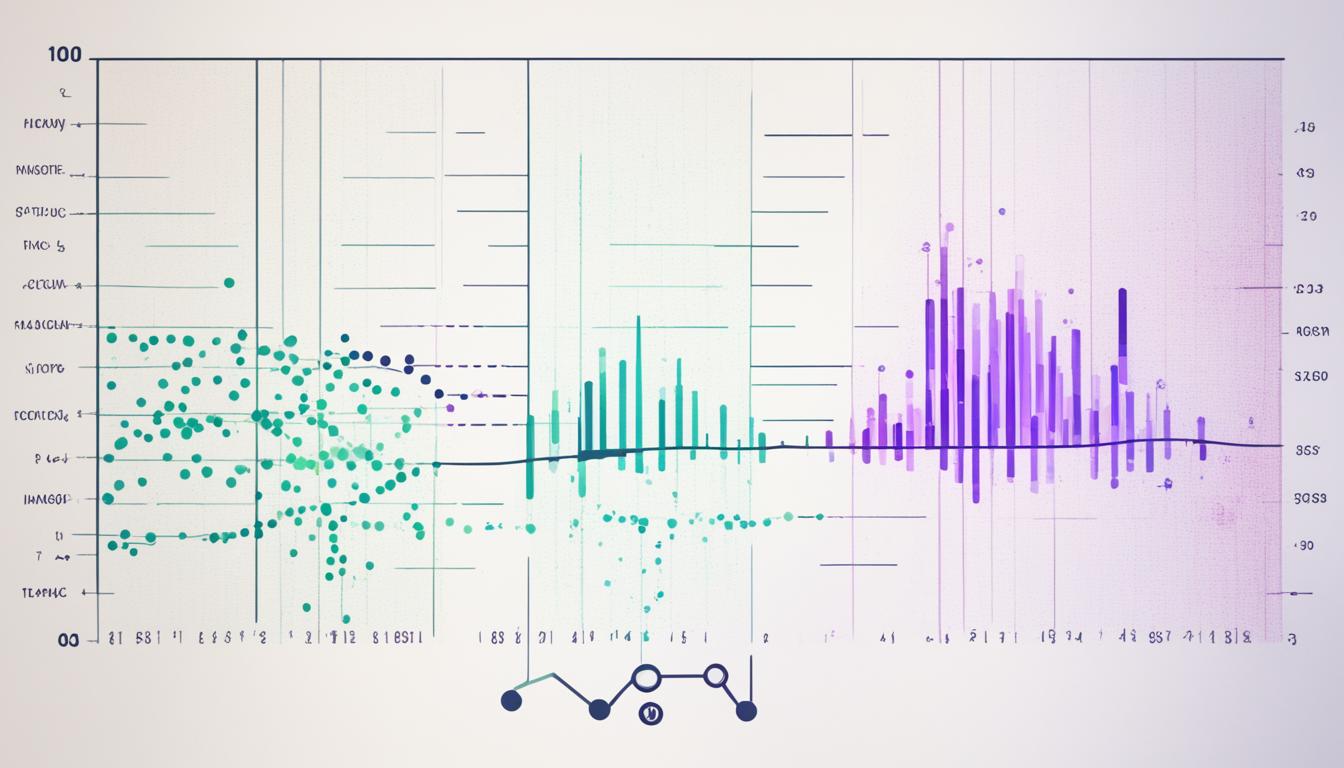As a woman, I keep a close eye on my body’s changes, especially my breasts. I’ve seen them grow and shrink, often because of my changing hormones. This journey of ups and downs is something many women experience. It can be both exciting and confusing.
Hormones are key to our health and affect features like breast size. Changes happen during our periods, pregnancies, or menopause. Knowing how hormonal balances impact our breasts is crucial. I find this topic very interesting and want to learn more.
Our hormones, like estrogen and progesterone, fluctuate. This affects our breast size and density. Other conditions, such as thyroid problems and PCOS, can influence this too. In this article, we’ll explore these hormone-breast connections.
Learning about these links helps us notice when something’s off. It empowers us to get the care we might need. Our breasts are central to our womanhood. Their health is very important.
Key Takeaways
- Hormones play a crucial role in determining breast size and appearance.
- Imbalances in hormones like estrogen and progesterone can lead to changes in breast size, density, and overall breast health.
- Hormonal fluctuations occur naturally during a woman’s life, such as during menstrual cycles, pregnancy, and menopause.
- Conditions like thyroid disorders and PCOS can also contribute to hormonal imbalances and breast changes.
- Understanding the link between hormonal imbalances and breast transformations is essential for women to recognize concerning changes and seek appropriate medical care.
Understanding Hormones and Their Role
Hormones are key to keeping our bodies working well. They control things like how fast we use up food for energy. They also affect our mood, development, and sex life. It’s like they’re tiny messengers sending signals to different parts of our body.
Types of Hormones Affecting Women’s Health
For women, key hormones include estrogen, progesterone, and more. These hormones help control a lot of body processes. If their levels are off, it can create health issues. This includes problems with mood, energy, and more.
Endocrine Glands and Hormone Production
The endocrine system makes sure our hormones are in balance. This system includes glands like the adrenal, thyroid, and pancreas. They work together to keep our hormones just right. Knowing how they interact is vital for our health.
Hormonal Changes and Breast Transformations
A woman’s breasts change a lot due to hormonal shifts throughout her life. During a woman’s period, more estrogen makes breasts swell and feel sore. A diet high in fat and caffeine can make these changes more pronounced.
Menstrual Cycle and Breast Fluctuations
The menstrual cycle causes breasts to swell, feel tender, and change in sensitivity, all due to changing estrogen levels. These changes are completely normal.
Pregnancy and Increased Breast Size
While pregnant, the body’s preparations for breastfeeding increase breast size. This is due to more progesterone and estrogen. Additionally, nipples might leak fluid or form lumps. These changes are natural and support the child’s development.
Perimenopause and menopause also lead to breast adjustments. Changes in estrogen and progesterone can result in soreness, altered appearance, and increased breast cancer risk.
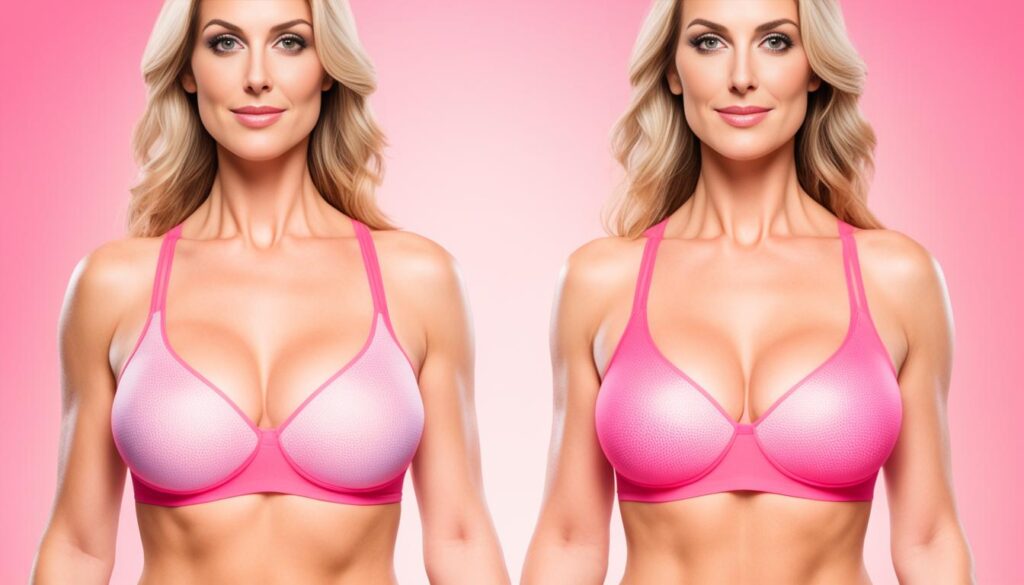
Perimenopause and Menopause: Breast Changes
As women near menopause, their breasts undergo big changes. This happens because of hormone ups and downs. In perimenopause, many feel breast soreness. It’s not quite like the pain you get with pregnancy or periods. Progesterone and estrogen levels swinging cause this. Some see their breasts change in shape and size. This is a time when other menopausal signs like hot flashes, irregular periods, and vaginal dryness may start, too.
Menopause brings another change: the breast cancer risk increases. It’s important for women to watch for any odd breast changes. Regular health check-ups will help catch and manage potential problems early.
| Breast Changes During Perimenopause | Breast Changes During Menopause |
|---|---|
| Breast soreness due to hormonal fluctuations | Increased risk of breast cancer |
| Changes in breast shape and size | Decreased breast density and size |
| Coinciding symptoms: hot flashes, irregular periods, vaginal dryness | Reduced estrogen levels leading to breast changes |
Can hormonal imbalance lead to smaller breasts?
I’ve seen how hormonal changes can make breasts smaller. Estrogen, a big part of this, affects breast size and density.
Estrogen Levels and Breast Density
Low estrogen levels, like in menopause, make breast tissue less dense. This makes breasts seem smaller. Estrogen keeps breasts full and maintains their size, so when it drops, that changes.
Progesterone Imbalance and Breast Size
Progesterone also affects breast tissue development. An imbalance, possibly from PCOS or hormonal shifts, lowers breast size. Progesterone is crucial for the breast’s ducts and glandular tissue growth.
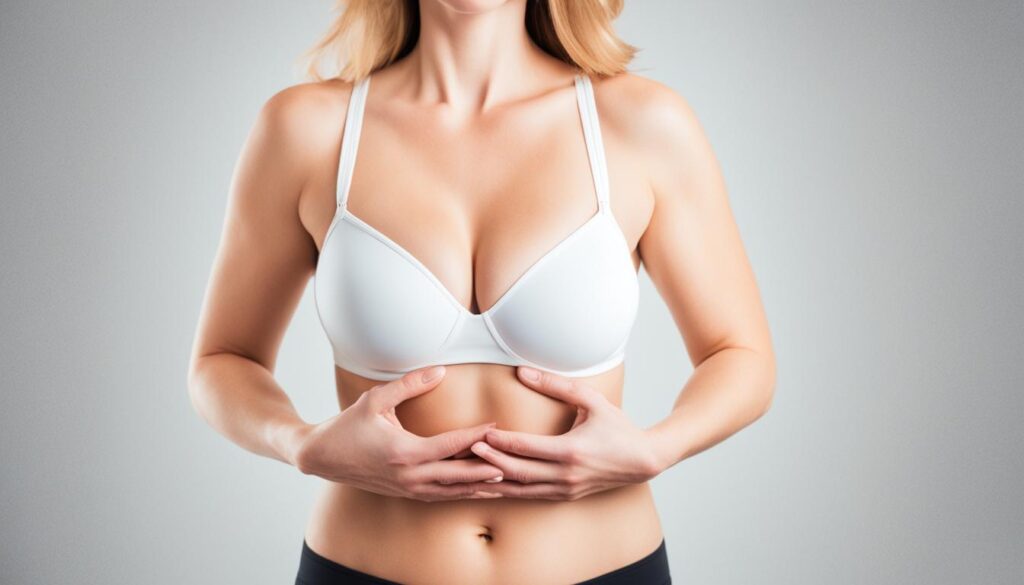
Hormonal imbalances affect everyone differently. Health, genes, and how you live can also play a role. If you notice changes in your breasts, talk honestly with your doctor. They can pinpoint the cause and help keep your breasts healthy.
Hormones, Aging, and Breast Cancer Risk
As we age, our bodies change. These changes, paired with hormonal shifts, can up our risk for breast cancer. The more estrogen we are exposed to in a lifetime, the higher the risk for some women. When we hit menopause also plays a big part in this risk factor.
Estrogen Exposure and Cancer Development
Having a lot of estrogen in our system for a long time can amp up breast cancer chances. Estrogen makes breast cells grow and divide. This can eventually lead to cancerous lumps.
Hormone Replacement Therapy (HRT) Considerations
Hormone replacement therapy (HRT) may seem like a good idea for easing menopause woes. It tackles issues like hot flashes and dryness. But, it’s also linked to a higher risk of breast cancer. It’s key to talk with your doctor before opting for HRT.
For tackling breast cancer risk, getting regular mammograms from age 40 is vital. This helps catch any issues early. With proper check-ups and a healthy lifestyle, women can better deal with the effects of hormones and aging. They can actively protect their well-being.
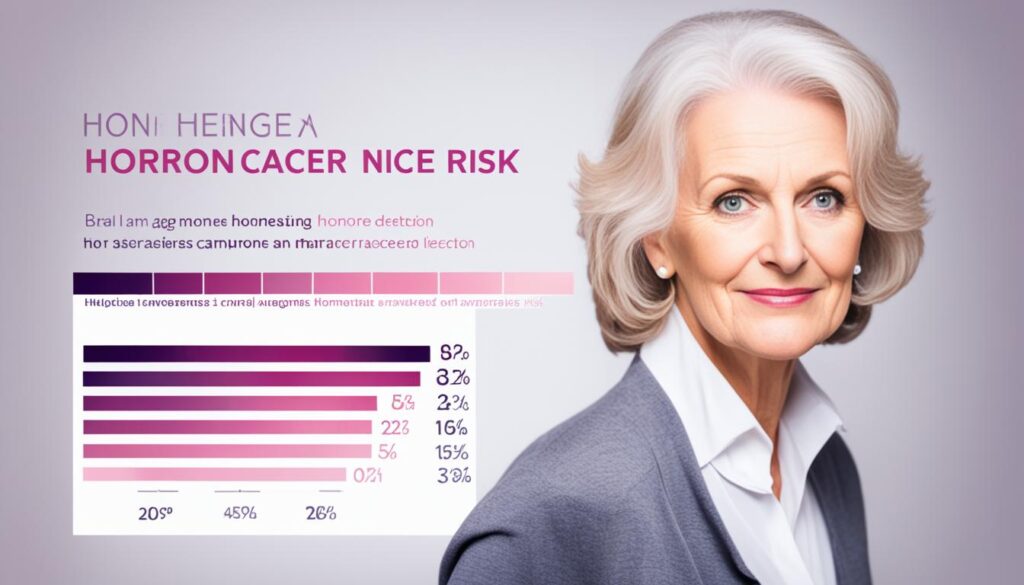
Breast Changes Throughout Life Stages
Women’s breasts change a lot through life’s various stages. These changes start in puberty and continue through menopause. They are heavily influenced by our body’s hormonal changes.
Puberty and Breast Development
At the start, breasts form in the womb along with the nipple and milk-duct system. The most exciting changes happen during puberty. Estrogen drives breast growth significantly. Fat increases in the breasts, and the duct system expands, giving them a fuller look. This change is a big shift from being a girl to becoming a woman.
Post-Pregnancy Breast Alterations
During and after pregnancy, breasts undergo huge changes. Early on, progesterone makes the breasts swell and nipples turn darker. By the mid to late pregnancy, breasts are ready to produce milk for the baby. After having the baby, breasts can change in shape, size, and gain stretch marks as they adapt to motherhood. This reflects the body’s changes related to motherhood’s demands.
Aging and Breast Transformations
As women get older, their breasts undergo more changes. During menopause, estrogen levels drop, making breast tissue drier and lose its elasticity. This can lead to sagging. Yet, weight gain can also make breasts bigger. The mammary glands start to shrink after about age 35. This process continues as a part of aging.
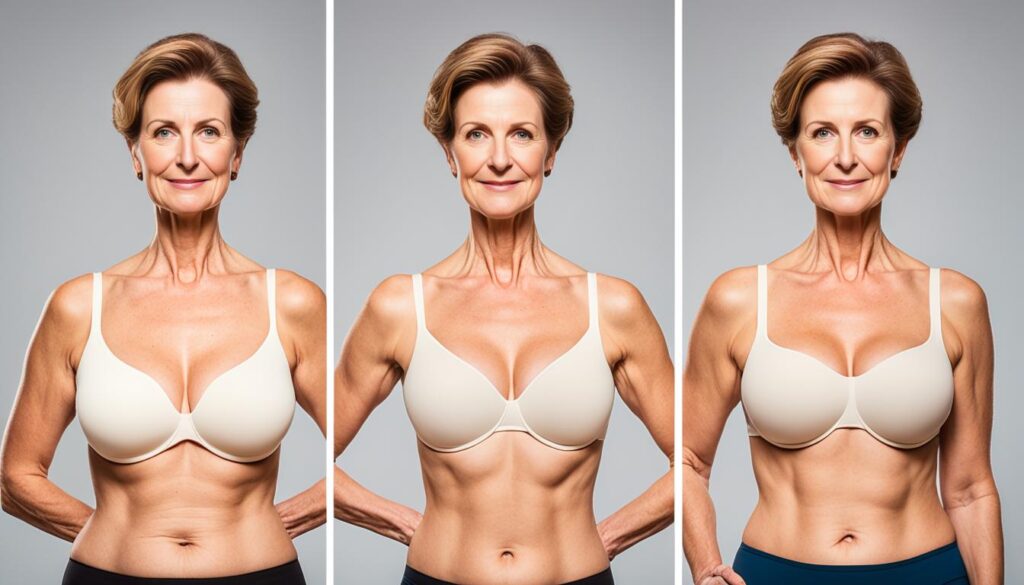
Identifying Concerning Breast Changes
As we get older, our breasts change. But, some changes need attention. Look out for new lumps in the breast or underarm. Also, pay attention to redness or flaky skin around the breast or nipple. Other signs are thickening or swelling of the breast, dimpling of the skin, nipple retraction, nipple discharge, and unexplained pain.
Lumps and Breast Cancer Symptoms
Noticing a new lump is worrying and could be a sign of breast cancer. It’s crucial to see a doctor for any unknown lumps. They might do tests like a mammogram or biopsy to check.
When to See a Doctor
Feeling any of the listed breast changes means you should see a doctor. They will do a check-up. If needed, they might recommend tests like a mammogram to find if there’s breast cancer.

Managing Hormonal Imbalances and Breast Health
Many symptoms from changing hormones can be handled with lifestyle changes and medical help. Women can work to keep their hormones balanced and breasts healthy. This is by taking active steps towards wellness.
Lifestyle Adjustments for Hormonal Balance
Getting enough sleep, eating well, and staying active are key. A good night’s sleep, a diet filled with fruits and veggies, and exercise can improve hormone levels. This can make symptoms of hormonal changes better too.
Medical Treatment Options
Sometimes, if hormonal issues are severe, doctors might suggest hormone therapy. This could mean replacing estrogen, progestin, or both. These treatments aim to balance out hormones and protect breast health. By working with their doctor, women can come up with a plan for their hormones and breast health.
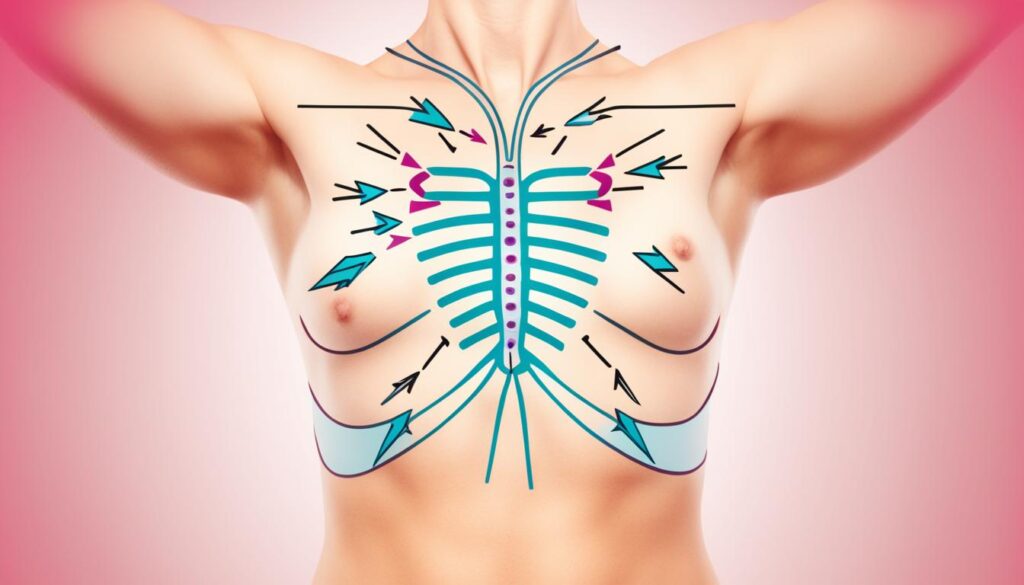
The Importance of Regular Screening
It’s crucial to have regular breast screenings like mammograms. They help check your breast health and find any issues, such as breast cancer. Starting at age 40, getting mammograms once a year is the general rule. This keeps you on top of your breast health, helping spot and deal with any problems quickly.
Mammogram Recommendations
The American Cancer Society advises women to start yearly mammograms at 40 if at average risk. This check is vital for noticing any strange changes in your breast tissue, especially signs of breast cancer. Following these guidelines means you’re actively caring for your breast health. It helps find and treat problems early.
Building a Relationship with Your Healthcare Provider
Creating a good bond with a healthcare provider who knows your history is as crucial as checkups. They can help with any breast changes or issues, making sure you get help fast. Regular visits and talking openly with your provider are key. They ensure you’re up to date on your breast health and can deal with any hormonal imbalances or factors changing your breasts.
Make regular screening and mammogram guidelines a priority. Also, make sure you have a close relationship with your healthcare provider. These steps are proactive. They help keep your breasts healthy and catch any problems early. Remember, your breast health is a big part of your overall well-being. Taking good care of your breasts is very important.
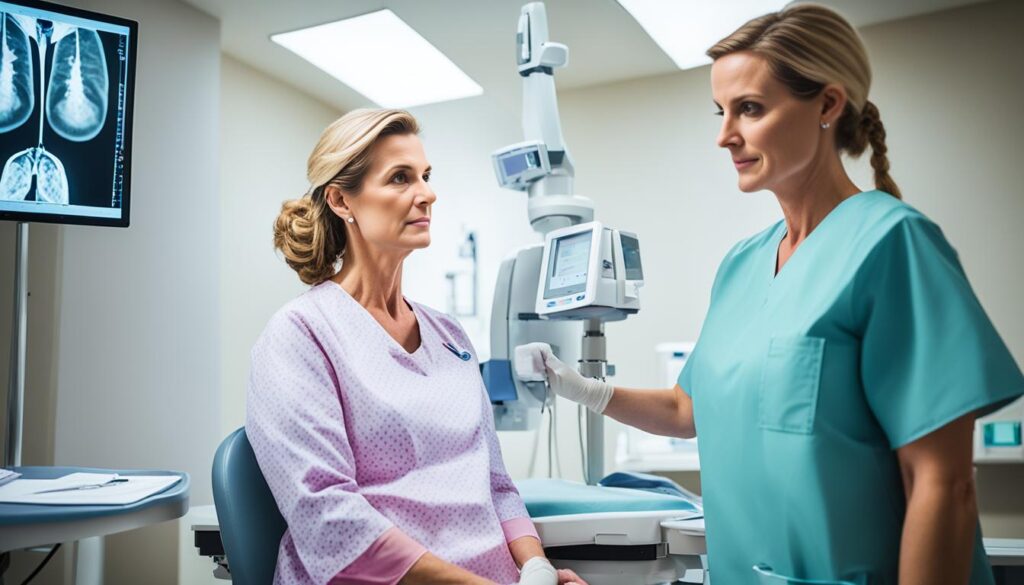
Conclusion
Hormonal imbalances can indeed lead to smaller breasts. They cause a range of other breast changes too. It’s key for women to know how hormones like estrogen and progesterone affect breast development, size, and health. This helps them catch concerning changes early and get the right care.
Staying on top of breast health is vital. This means getting regular screenings and talking openly with your doctor. This way, women can manage hormonal imbalances well. They can ensure their breasts stay healthy over time. It’s normal for hormones and breasts to change. But, staying informed and alert helps. It lets women handle these challenges and keep their breasts in the best shape.
